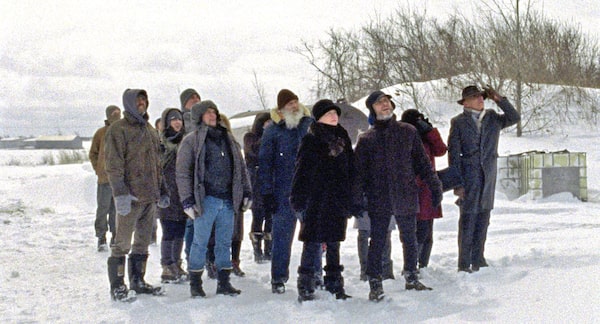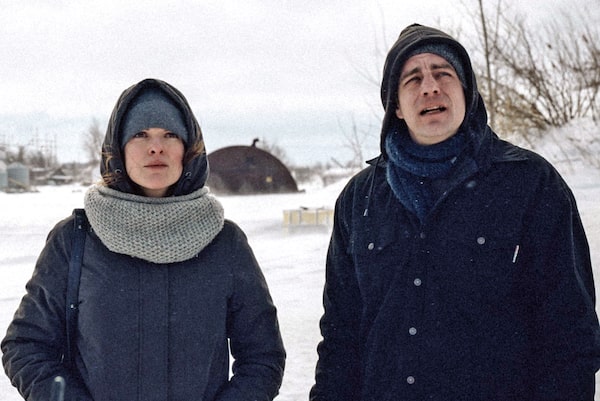
Filmed in a glorious super 16mm, Ghost Town Anthology's colour palette is full of rich, earthy tones and endless wintry textures.Courtesy of TIFF
Ghost Town Anthology
Written and directed by: Denis Côté
Starring: Jean-Michel Anctil, Josée Deschênes and Robert Naylor
Classification: N/A
97 minutes
The history of Canadian cinema can be found, in a manner of speaking, at the Art Gallery of Ontario. Inside the building’s Canadian collection, there are the naturalistic paintings of Cornelius Krieghoff, who depicted the everyday 19th-century experience of settlers against the wilderness of pastoral landscapes. There are the pop illustrations of William Kurelek, who in neon colours brought the visual punchlines of Saturday-morning cartoons to his portraits of the changing rural countryside. There are the formal abstractions of Paul-Émile Borduas, who made compositions organized by contrasting black and white paint blotches.
Compare these works with the development of particular styles in homegrown cinema, and some clear correspondences emerge. Michel Brault’s candid documentaries that captured an unfiltered rustic way of life in the Quebec countryside recall the naturalism of Krieghoff. Gilles Carles’s playful filmmaking that emphasized vivid details, cartoonish characters and ridiculous scenarios is akin to the sensibility of Kurelek. And Denis Côté’s minimal films, with their negative energy, fragmented narratives and stark cinematography, edge close to Borduas. Côté’s 11th film, Ghost Town Anthology, only underlines this theory.
The work of Borduas can be characterized by four elements: patches of black shapes surrounded by white space, diffuse and heightened areas of interests, an abstraction in opposition to representation and an attempt to alter human perception. Borduas’s work seems to be asking the central question of how he can create art to make people see the world differently. Ghost Town Anthology attempts an answer.

The film is a loose adaptation of Quebec writer Laurence Olivier’s book Répertoire des villes disparues.Courtesy of TIFF
The film is a loose adaptation of Quebec writer Laurence Olivier’s book Répertoire des villes disparues. It begins with a car crash and the death of a young man. The victim’s small village is in shock and in grief. Was it an accident or was it suicide? The deceased’s brother and mother struggle with the news. The mayor desperately tries to make sure that everyone is okay. A young woman becomes frazzled. Two older couples try to go on with their lives, and so on. But this is less a drama of mourning than a horror film. Ghosts start to haunt the townspeople, and there is something especially unnerving about how these apparitions start to pop up. Think 2014′s It Follows but in the barren and snow-ridden rural Québécois countryside. Côté’s village is filled with the director’s signature haunted houses, where for its isolated residents, hearing a creaking floorboard or a shuttering window can quickly lead to a threatening situation. Ghosts start to appear that are wearing the most haunting winter wear.
Côté is a filmmaker of sensations. The storytelling is fragmented between the different residents and progresses in moods of despair and shock, resilience and community. The parallel plotting resembles the work of Robert Altman, a perhaps surprising influence for Côté. But this Altman-esque, multicharacter narrative is ultimately about defining a real sense of community – the ghosts are able to bring everybody together.
Filmed in a glorious super 16mm, the film’s colour palette is full of rich, earthy tones and endless wintry textures. The focus on the barrenness of the outdoors, the extensiveness of the snow and the violence of the wind makes its setting especially unnerving – as if Côté is asking us all to see everything differently, Borduas-style.
The thematic question that centres the film is how can we deal with death and bereavement. Questions of mortality have been front and centre in Côté’s recent films, but here they take on a more prominent role. In the director’s 2013 drama Vic and Flo Saw a Bear there is the outsider couple whose lives get brutally interrupted by a violent figure from their past. In 2016′s Boris Without Béatrice there is the retreating toward the countryside to take care of an ailing loved one. Now, Côté seems to be exploring what remains after death through these spirits that paradoxically live on. This is not a cynical or dark vision, but one of resilience. For Ghost Town Anthology’s many characters, after seeing things differently they can start to also live differently.
Côté has a reputation of being something of a punk filmmaker. But if there is anything transgressive about Ghost Town Anthology it is its optimistic vision, where instead of having characters remain alienated and separated, they come together, find themselves and form a community. It is a story of putting problems behind and starting a new page. As with Borduas, things will be different. But they will be brighter, too.
Ghost Town Anthology opens March 15 in Toronto.